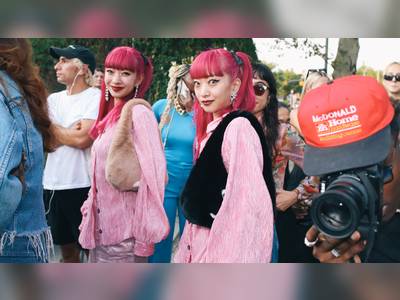Known by her first name, Ajuma, as a rookie
was a model in the New York Fashion Week of 2003 for Ford Models’ top
clients like Vivianne Westwood and Alexander McQueen.
She says
that every designer makes her feel and look different. The Phat Farm
label is hip-hop and very relaxed and very causal compared to Alexander
McQueen label, which is haute couture (high dressmaking) and chic that
makes her feel sophisticated. “Victoria’s Secret makes me feel sexy,”
says Ajuma with a giggle.
Born in Lodwar, she has won the
international fashion industry over with her confidence and looks: even
dark skin, short hair, high cheekbones, and full lips. It started four
years ago when she participated in the Miss Tourism Kenya competition.
Although she was a favourite of the crowd, she did not win.
Lyndsey
McIntyre of Surazuri Models spotted her “supermodel” potential and
sponsored the then 19- year-old to enter the Ford Models Supermodel of
the World Search 2003 to represent Kenya.
She is in town to
represent the agency in the finale of M-Net’s Catwalk Kenya. The winner
of this competition is expected to represent Kenya in the Ford Models
competition in New York next year and compete with over 50
contestants.
What makes her stand out from other Ford winners
is that she is the first black model to ever win this competition that
was not aimed at solely promoting black models.
Currently, the
black models account for only four per cent of the full-time working
models. A good case in mind is this year’s New York’s Fashion Week.
New York Times noted that there were few Latina, Asian and black models
on the catwalk and the Calvin Klein label had used only white models.
“It
is really sad when you flip through Vogue and all you see are white
models,” she says. It has not gone unnoticed though. Naomi Campbell, a
black supermodel and others like Tyra Banks and Iman have spoken on
this subject a lot lately.
They argue that the industry is
discriminating against black models and according to some it is worse
than in the 1960s. “We have formed a group that gets together and talk
about our problems,” says Ajuma.
A group of aspiring American
black models are forming their own lobby too. Then the Ajumas and Imans
of that world tell them how difficult it is especially since the
industry is dominated by whites, but keep encouraging them to pursue
their dreams.
Hard times though. Ajuma says in certain
audition podiums, black models have been somewhat embarrassed when a
designer does not mince words and thrust onto the models a shocker
that the event was not for blacks! She adds that black models do get
bookings “here and there,” but still feels they (black models) have
kind of accepted this humiliation. This is not right, Ajuma says.
“Some
designers claim that black models make their clothes look too sexy and
would prefer the thin white models,” she says. And the models being
too thin has been a hot topic lately. In the last two years, the
fashion fraternity has been caught in a whirlwind of how unhealthy the
thin models might be.
The Madrid Fashion Week, in Spain, was
the first one to ban models using Body Mass Index (BMI) — ratio based
on using weight and height — in 2006.
The modelling agencies
came out fighting because about 30 per cent of the models were turned
away, including Ajuma. She has an athletic body and initially trained
as a runner.
Nevertheless, her BMI was under what was
considered healthy, but when checked, doctors found her blood sugar
to be all right. Her metabolism was also okay.
The spark that
ignited all this was the death of a British model who succumbed to
eating disorder related complications. With that comes the blame that
the fashion industry makes women and men to be anorexia and bulimia to
become thin. “It depends on the people you choose to be around,” she
says.
Modelling is not a long time career. By 26, a model is
considered to be old. “I am focused on my family because they depend on
me and the future. I am saving to study. I want to be a midwife.”

Phil Oh’s Best Street Style Photos From the New York Fashion Week Spring 2023 Shows
This season New York Fashion Week has brought in a worldwide crowd of stars thanks to a packed season that even includes shows...












